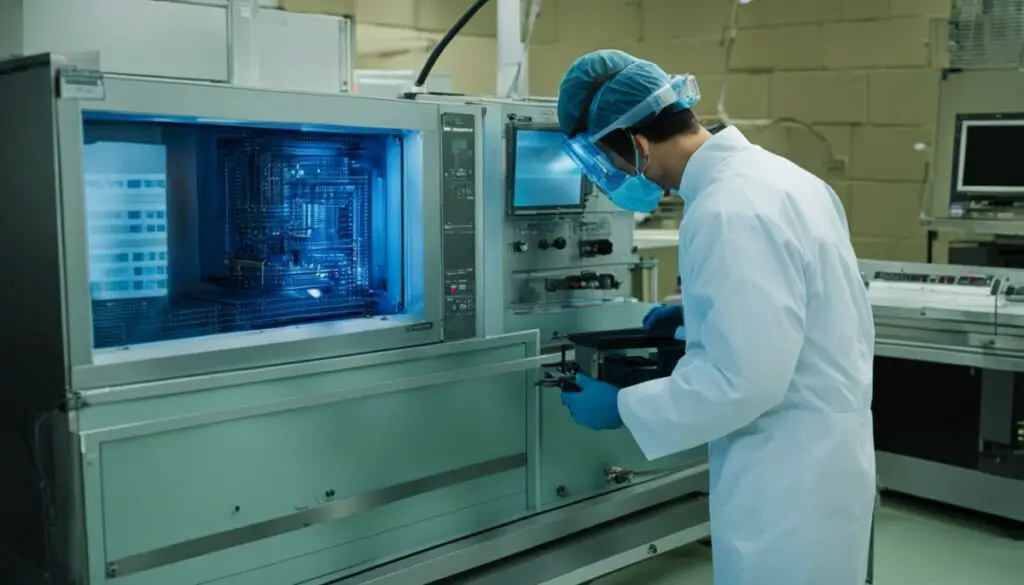Last Updated on 5 months by Francis
Welcome to our exploration of microwaves and infrared waves! These two terms are often used interchangeably, but are they really the same thing? Let’s dive into the fascinating world of electromagnetic radiation and uncover the truth.
Contents
Key Takeaways:
- Microwaves and infrared waves are both part of the electromagnetic spectrum.
- While they have different frequencies and wavelengths, they are both forms of electromagnetic radiation.
- Microwaves have slightly higher energy and shorter wavelengths compared to infrared waves.
- Microwaves have various applications including microwave communication and cooking, while infrared waves are used in heat detection and night vision technology.
- Understanding the properties and behavior of these waves enhances our knowledge of electromagnetic radiation.
Understanding the Electromagnetic Spectrum
The electromagnetic spectrum encompasses a wide range of types of electromagnetic radiation, including radio waves, microwaves, infrared light, visible light, ultraviolet light, X-rays, and gamma-rays. Each type of radiation has unique properties and characteristics.
Radio waves have the longest wavelengths and lowest frequencies in the spectrum, making them suitable for long-distance communication, such as radio broadcasting and cellular networks.
Microwaves have shorter wavelengths and higher frequencies than radio waves. They are commonly used in microwave technology for communication, heating, and cooking. Microwaves are also utilized in radar systems for object detection and tracking.
Infrared light lies between microwaves and visible light. It is commonly associated with heat and is utilized in various applications such as heat detection, night vision technology, and remote controls.
Infrared waves have longer wavelengths compared to visible light, but shorter wavelengths compared to microwaves. They occupy a unique position within the electromagnetic spectrum.
| Type of Electromagnetic Radiation | Range of Wavelengths | Range of Frequencies |
|---|---|---|
| Radio Waves | Longest | Lowest |
| Microwaves | Shorter than radio waves, longer than infrared light | Higher than radio waves, lower than infrared light |
| Infrared Light | Shorter than microwaves, longer than visible light | Higher than microwaves, lower than visible light |
| Visible Light | Shorter than infrared light | Higher than infrared light |
| Ultraviolet Light | Shorter than visible light | Higher than visible light |
| X-rays | Shorter than ultraviolet light | Higher than ultraviolet light |
| Gamma-rays | Shortest | Highest |
Exploring Microwaves and Infrared Waves
When it comes to the electromagnetic spectrum, microwaves and infrared waves play distinct roles. Although they belong to the same spectrum, they have unique characteristics that differentiate them from each other. Let’s delve deeper into the world of microwaves and infrared waves and explore their wavelengths, frequencies, and applications.
Understanding Wavelengths and Frequencies
Microwaves have wavelengths ranging from about 1 millimeter to 1 meter and frequencies ranging from about 1 gigahertz to 300 gigahertz. These shorter wavelengths enable microwaves to interact with water molecules, making them ideal for heating food in microwave ovens. On the other hand, infrared waves have longer wavelengths, typically ranging from 700 nanometers to 1 millimeter. Their frequencies are below those of visible light, allowing them to be utilized in various heat detection and night vision technologies.
Diverse Applications in the Electromagnetic Spectrum
Microwaves and infrared waves find applications in different fields. Microwaves are commonly used in microwave communication systems to transmit data, voice, and video information effectively. They are also utilized in radar systems to detect and locate objects. Infrared waves play a vital role in heat detection and imaging applications, making them invaluable in fields such as medicine, agriculture, and security. Additionally, infrared light enables night vision technology, empowering users to see in low-light or dark conditions.
Table: Comparing Microwaves and Infrared Waves
| Microwaves | Infrared Waves |
|---|---|
| Shorter wavelengths and higher frequencies | Longer wavelengths and lower frequencies compared to visible light |
| Used in microwave ovens and wireless communication | Applied in heat detection, night vision technology, and remote controls |
| Interact with water molecules, enabling efficient heating | Interact with objects emitting heat, providing valuable information |
While microwaves and infrared waves are unique in their properties and applications, they are both essential components of the electromagnetic spectrum. Understanding their differences and similarities allows us to appreciate the vast range of electromagnetic radiation and its impact on various technological advancements.
The Applications of Microwaves

Microwaves have revolutionized various industries with their wide range of applications. From communication systems to cooking appliances, microwave technology has made our lives more convenient and efficient.
Microwave Communication:
Microwaves play a crucial role in communication systems, especially in long-distance transmission of data, voice, and video information. They are widely used in microwave communication networks, such as satellite, microwave towers, and fiber optics. These systems utilize microwave frequencies and the line-of-sight transmission method to ensure reliable and high-speed communication.
Radar Systems:
Radar systems rely on microwaves to detect and locate objects in their surroundings. They emit microwave signals and analyze the reflections to determine the presence, distance, and speed of objects. Radar technology has numerous applications, including air traffic control, weather forecasting, navigation systems, and military operations.
Cooking with Microwaves:
One of the most familiar applications of microwaves is in microwave ovens. These appliances use microwave radiation to heat food quickly and efficiently. Microwaves penetrate the food, causing water molecules to vibrate and generate heat, resulting in faster cooking times. The convenience and speed of microwave cooking have made it a staple in modern kitchens worldwide.
Overall, the applications of microwave technology are diverse and impactful. Whether it’s enabling seamless communication, enhancing radar systems, or simplifying our cooking experience, microwaves continue to play a vital role in various aspects of our daily lives.
The Role of Infrared Waves

Infrared waves play a vital role in various fields, particularly in heat detection and imaging applications. Objects that emit heat also emit infrared radiation, and this property makes it possible to detect and measure temperature variations. Infrared waves are commonly used in thermal cameras and sensors, allowing us to visualize and identify areas of different temperatures. This technology has applications in industries such as manufacturing, building inspections, and even medical diagnostics.
Another significant application of infrared waves is in night vision technology. Infrared light is invisible to the human eye but can be detected by specialized devices. Night vision goggles and cameras utilize infrared waves to detect objects in darkness by capturing and amplifying the infrared radiation they emit. This technology is widely used in law enforcement, military operations, and wildlife observation, enabling enhanced vision and visibility in low-light conditions.
Infrared waves have longer wavelengths compared to visible light, but shorter wavelengths compared to microwaves.
Understanding the properties and behavior of infrared waves allows us to harness their unique characteristics for various purposes. Whether it’s detecting heat, enhancing visibility in the dark, or exploring the thermal properties of objects, infrared waves continue to be an invaluable tool in numerous industries and applications.
| Application | Description |
|---|---|
| Heat Detection | Utilized in thermal cameras and sensors to detect and visualize temperature variations in objects and surfaces. |
| Night Vision Technology | Used in devices such as night vision goggles and cameras to enhance visibility in low-light conditions by detecting and amplifying infrared radiation. |
| Manufacturing | Applied in various manufacturing processes, such as quality control and defect detection, by analyzing thermal patterns. |
| Building Inspections | Enables professionals to identify insulation gaps, air leaks, and other thermal anomalies in buildings for energy efficiency assessments. |
| Medical Diagnostics | Used in medical imaging techniques, such as thermography, to aid in the diagnosis and monitoring of certain conditions. |
The Similarities and Differences Between Microwaves and Infrared Waves

Both microwaves and infrared waves are forms of electromagnetic radiation, but they have distinct characteristics and applications. Understanding the similarities and differences between these waves can provide insights into their properties and uses.
Similarities:
- Both microwaves and infrared waves are part of the electromagnetic spectrum, which includes various types of radiation.
- Both waves carry energy and can interact with matter.
- Both can be used in practical applications such as communication and detection systems.
Differences:
- Microwaves have higher frequencies and shorter wavelengths compared to infrared waves.
- Microwaves are commonly used in microwave ovens for cooking, while infrared waves are utilized in heat detection and night vision technology.
- Microwaves have frequencies ranging from about 1 gigahertz to 300 gigahertz, while infrared waves have frequencies below those of visible light.
Understanding these similarities and differences helps us appreciate the unique properties and applications of both microwaves and infrared waves within the electromagnetic spectrum.
“Microwaves and infrared waves have distinct characteristics and uses within the electromagnetic spectrum.”
Energy, Wavelength, and Frequency in the Electromagnetic Spectrum
Understanding the properties of electromagnetic radiation is crucial to comprehending the behavior and characteristics of waves in the electromagnetic spectrum. Three key concepts that greatly contribute to this understanding are energy, wavelength, and frequency.
Energy is directly associated with the frequency of electromagnetic waves. The higher the frequency, the greater the energy carried by the wave. Wavelength, on the other hand, refers to the distance between two consecutive peaks or troughs of a wave. Frequency and wavelength have an inverse relationship, meaning that as the frequency increases, the wavelength decreases, and vice versa.
To further illustrate this relationship, let’s take a look at the electromagnetic spectrum as a whole. At one end of the spectrum, we have high-frequency, high-energy waves such as gamma-rays and X-rays. These waves have short wavelengths, measuring in nanometers or even smaller. On the other end, we have low-frequency, low-energy waves like radio waves. These waves have long wavelengths, measuring in meters or even kilometers. Between these extremes, we find waves of varying frequencies and wavelengths, including microwaves and infrared waves.
| Wave Type | Frequency Range | Wavelength Range |
|---|---|---|
| Gamma-rays | 10^19 Hz – 10^24 Hz | < 10 picometers |
| X-rays | 10^16 Hz – 10^19 Hz | 10 picometers – 10 nanometers |
| Visible Light | 4.3 x 10^14 Hz – 7.5 x 10^14 Hz | 400 – 700 nanometers |
| Microwaves | 1 GHz – 300 GHz | 1 millimeter – 1 meter |
| Infrared Waves | 300 GHz – 400 THz | 700 nanometers – 1 millimeter |
| Radio Waves | < 300 GHz | > 1 millimeter |
By analyzing the table above, we can see that microwaves fall within a frequency range of 1 GHz to 300 GHz, with wavelengths ranging from 1 millimeter to 1 meter. Infrared waves, on the other hand, have frequencies ranging from 300 GHz to 400 THz and wavelengths ranging from 700 nanometers to 1 millimeter. While microwaves and infrared waves differ in their frequency and wavelength ranges, they both play important roles in various applications within the electromagnetic spectrum.
Observing and Detecting Microwaves and Infrared Waves

Scientists and astronomers employ various techniques and instruments to observe and detect microwaves and infrared waves. Due to atmospheric interference, some observations require telescopes and detectors placed on satellites. These satellite-based observatories provide a clear and unobstructed view of microwave and infrared radiation from space. Ground-based equipment is also used to detect and study these forms of electromagnetic radiation.
“Observing microwaves and infrared waves from space allows for a comprehensive understanding of their behavior and properties.”
One example of a satellite-based observatory is the Planck spacecraft, which was specifically designed to map the cosmic microwave background radiation, providing valuable insights into the early universe. The Infrared Astronomical Satellite (IRAS) and the European Space Agency’s Herschel Space Observatory are other examples of satellites that have contributed to our understanding of infrared waves.
On the ground, scientists use specialized equipment such as radio telescopes, microwave detectors, and infrared cameras to detect and study these forms of electromagnetic radiation. They can analyze the wavelengths and frequencies of microwaves and infrared waves to gain insights into various phenomena, including the composition of celestial objects and the thermal properties of materials.
“By detecting and studying microwaves and infrared waves, scientists can unlock valuable information about the universe and our world.”
In summary, scientists and astronomers utilize a range of techniques and instruments, both from space and on the ground, to observe and detect microwaves and infrared waves. These observations provide valuable insights into the behavior, properties, and origins of these forms of electromagnetic radiation. Whether through satellite-based observatories or ground-based equipment, the study of microwaves and infrared waves continues to expand our understanding of the universe and its many mysteries.
Historical Uses of Microwaves and Infrared Waves

Throughout history, microwaves and infrared waves have played significant roles in various fields, revolutionizing the way we live and understand the world around us. Let’s explore the historical uses and milestones of these forms of electromagnetic radiation.
The Historical Significance of Microwaves
Microwaves were first discovered and studied in the early 20th century, leading to important breakthroughs and practical applications. One key milestone was the invention of the microwave oven in 1945 by Percy Spencer, an engineer at Raytheon. This invention transformed food preparation, allowing for convenient and rapid cooking.
Another notable historical use of microwaves is in microwave communication systems, which emerged in the mid-20th century. Microwaves were utilized for long-distance communication, particularly in the development of radar systems during World War II. These systems revolutionized military operations and paved the way for advancements in communication technology.
The Historical Significance of Infrared Waves
Infrared waves have also played a critical role throughout history, particularly in the field of heat detection. In the late 19th century, the discovery of infrared radiation and its ability to detect heat led to advancements in thermal imaging and heat sensing technologies.
One significant historical use of infrared waves is in night vision technology. During World War II, infrared imaging devices were developed to allow soldiers to see in the dark by detecting the heat emitted by objects. This technology has since been widely adopted in various applications, including law enforcement, wildlife observation, and surveillance.
| Historical Uses of Microwaves | Historical Uses of Infrared Waves |
|---|---|
| Invention of the microwave oven | Advancements in thermal imaging |
| Development of microwave communication systems | Use in night vision technology |
| Revolutionized food preparation | Wide adoption in various fields |
As we can see, microwaves and infrared waves have made substantial contributions throughout history, transforming the way we cook, communicate, detect heat, and observe the world. These historical uses set the foundation for the further development and application of these forms of electromagnetic radiation in modern society.
The Future of Microwaves and Infrared Waves
As technology advances at a rapid pace, the future holds promising developments in both microwave technology and the applications of infrared waves. These two forms of electromagnetic radiation continue to shape various industries and have the potential to revolutionize our daily lives even further.
In terms of microwave technology, we can expect to see advancements in communication systems. With the growing demand for faster and more efficient data transmission, researchers are working on optimizing microwave frequencies to enhance wireless communication networks. This could lead to faster internet speeds, improved connectivity, and the ability to support emerging technologies like the Internet of Things (IoT) on a larger scale.
On the other hand, there are exciting possibilities for advancements in the applications of infrared waves. Infrared radiation has already proven valuable in heat detection and is widely used in night vision technology. However, ongoing research and development may uncover additional uses for infrared waves in fields such as medical imaging, security systems, and environmental monitoring. By harnessing the unique properties of infrared radiation, scientists hope to unlock new ways of detecting and analyzing the world around us.
Advancements in Microwave Technology
Microwave technology has come a long way since its inception, and it continues to evolve. Looking ahead, we can anticipate significant advancements in this field:
- Higher Frequencies and Lower Latency: With the rise of 5G networks, microwave technology will play a crucial role in providing high-speed wireless connections with lower latency. This will enable faster data transfer and improved real-time communication.
- Increased Efficiency in Power Consumption: Researchers are constantly working on refining microwave components and systems to reduce power consumption. This not only benefits the environment by minimizing energy waste but also extends the battery life of devices that rely on microwave technology.
- Integration with Emerging Technologies: Microwaves are expected to integrate seamlessly with emerging technologies such as autonomous vehicles, augmented reality, and virtual reality. These advancements will require robust and reliable microwave communication systems to facilitate smooth interactions between devices.
The Potential of Infrared Wave Applications
Infrared waves also hold immense potential for various applications in the future:
- Medical Imaging and Diagnosis: Infrared waves can penetrate human tissue more effectively than visible light, offering the potential for improved medical imaging techniques. This could lead to more accurate diagnoses and non-invasive procedures.
- Environmental Monitoring and Conservation: Infrared technology can be used to monitor and analyze environmental factors such as temperature, humidity, and air quality. This data can help in predicting and managing natural disasters, monitoring the health of ecosystems, and implementing more effective conservation strategies.
- Advanced Security Systems: Infrared-based security systems have already gained popularity due to their ability to detect body heat and movement. The future may bring even more sophisticated applications, such as facial recognition technology that utilizes infrared waves for enhanced accuracy and reliability.
As the world becomes increasingly interconnected, the role of microwave technology and the applications of infrared waves will continue to expand. With ongoing research, technological advancements, and innovative discoveries, the future holds immense possibilities for these forms of electromagnetic radiation. Embracing these advancements will enable us to unlock new capabilities and improve various aspects of our lives.
| Advancements in Microwave Technology | The Potential of Infrared Wave Applications |
|---|---|
| Higher Frequencies and Lower Latency | Medical Imaging and Diagnosis |
| Increased Efficiency in Power Consumption | Environmental Monitoring and Conservation |
| Integration with Emerging Technologies | Advanced Security Systems |
Conclusion
In conclusion, microwaves and infrared waves are distinct forms of electromagnetic radiation within the larger electromagnetic spectrum. While they have some similarities in terms of their interaction with matter and practical applications, they differ in terms of their frequencies, wavelengths, and specific uses.
Microwaves, with their higher energy and shorter wavelengths, find applications in microwave communication systems, radar systems, and cooking with microwave ovens. On the other hand, infrared waves, with their longer wavelengths, play a significant role in heat detection, night vision technology, and various imaging applications.
Understanding the properties and characteristics of these waves broadens our knowledge of electromagnetic radiation and its numerous applications in our daily lives. As technology continues to advance, the future holds exciting possibilities for further developments in microwave technology and the applications of infrared waves.
FAQ
Are microwaves a type of infrared wave?
No, microwaves and infrared waves are distinct forms of electromagnetic radiation within the larger electromagnetic spectrum.
What is the electromagnetic spectrum?
The electromagnetic spectrum encompasses all types of electromagnetic radiation, including radio waves, microwaves, infrared light, visible light, ultraviolet light, X-rays, and gamma-rays.
What are some practical applications of microwaves?
Microwaves are used in microwave communication systems, radar systems, and microwave ovens for cooking food quickly and efficiently.
How are infrared waves utilized?
Infrared waves are commonly used in heat detection and imaging, night vision technology, and various applications that involve detecting infrared radiation emitted by objects.
What are the similarities and differences between microwaves and infrared waves?
While microwaves and infrared waves are both forms of electromagnetic radiation, they differ in terms of frequencies, wavelengths, and specific uses.
How do energy, wavelength, and frequency relate to electromagnetic radiation?
Energy is directly associated with the frequency of the waves, while wavelength and frequency have an inverse relationship.
How are microwaves and infrared waves observed and detected?
Scientists and researchers use various techniques and instruments, including telescopes and detectors on satellites, to detect and observe microwaves and infrared waves.
What historical significance do microwaves and infrared waves hold?
Microwaves have revolutionized food preparation with the invention of the microwave oven, while infrared waves have played a crucial role in night vision technology and heat detection.
What does the future hold for microwaves and infrared waves?
As technology advances, there is potential for further developments in microwave technology and new applications for infrared waves.








